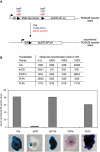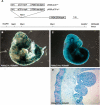High-efficiency FLP and PhiC31 site-specific recombination in mammalian cells
- PMID: 17225864
- PMCID: PMC1764711
- DOI: 10.1371/journal.pone.0000162
High-efficiency FLP and PhiC31 site-specific recombination in mammalian cells
Abstract
DNA site-specific recombinases (SSRs) such as Cre, FLPe, and phiC31, are powerful tools for analyzing gene function in vertebrates. While the availability of multiple high-efficiency SSRs would facilitate a wide array of genomic engineering possibilities, efficient recombination in mammalian cells has only been observed with Cre recombinase. Here we report the de novo synthesis of mouse codon-optimized FLP (FLPo) and PhiC31 (PhiC31o) SSRs, which result in recombination efficiencies similar to Cre.
Conflict of interest statement
Figures


References
-
- Branda CS, Dymecki SM. Talking about a revolution: The impact of site-specific recombinases on genetic analyses in mice. Dev Cell. 2004;6:7–28. - PubMed
-
- O'Gorman S, Fox DT, Wahl GM. Recombinase-mediated gene activation and site-specific integration in mammalian cells. Science. 1991;251:1351–1355. - PubMed
Publication types
MeSH terms
Substances
Grants and funding
LinkOut - more resources
Full Text Sources
Other Literature Sources
Molecular Biology Databases
Research Materials

